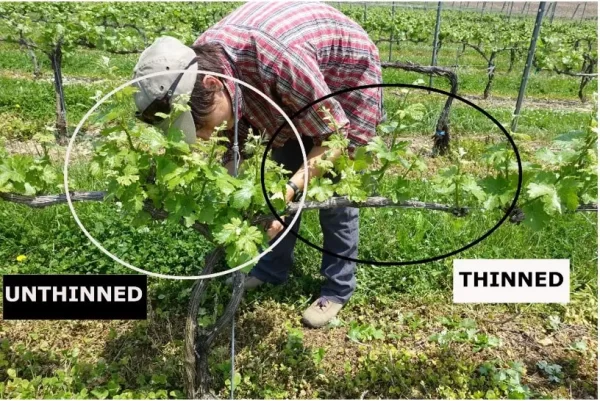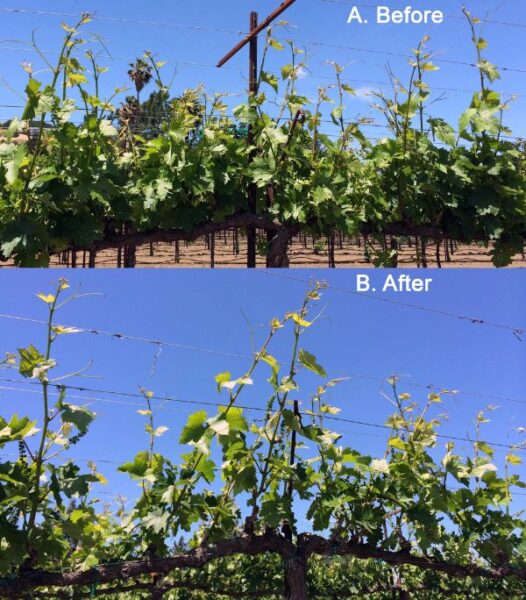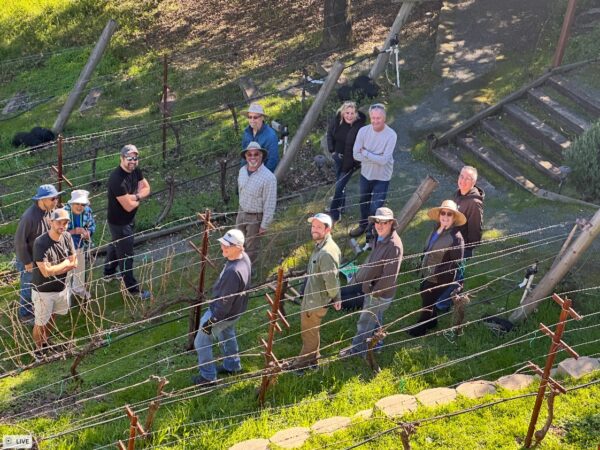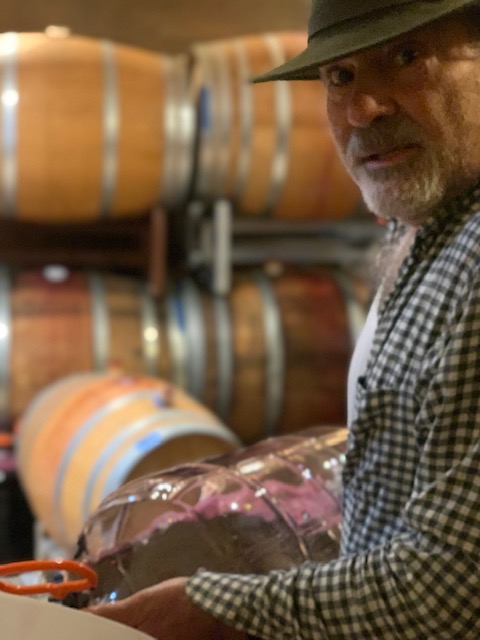Hi everyone, Pietro here with a couple vineyard and winemaking topics. Now that your vines are growing and we have had a few warm days you should be seeing some real growth happening. This is a reminder that you should be spraying approximately every two weeks (more often in wet or foggy locations) to control mildew, which grows whenever the temperature is between 70 – 85F. You should also be suckering the trunks of the vines while the suckers are soft and snap off easily – I buy a 10-pack of cheap gloves with rubber palms for this, and then move up to your fruiting cordons or canes and shoot thin those as well. If the suckers become too large, their removal damages the vine with rips and tears that leave exposed wood for diseases. Here are a couple pictures borrowed from Penn State and Lodi Winegrowers:


On to the technical stuff! Last week UC Davis held a presentation of current research topics at Greystone in St. Helena on both winemaking and viticulture research. I highly recommend attending these meetings since they are affordable and quite interesting. There will be one on June 4th at the legendary Oakville growing station focusing on vine growing which is linked here. I would attend if I could, perhaps you can catch a ride with Bill Saupe. Below is my summary of the presentations from last week.
- Red Blotch – This is something we have in our Lake County vineyard that is spreading throughout California. A link has been established to native California grapevines which suggests that it has been here all along. It is spread by TCAH (Tee-ka) otherwise known as the three-cornered alfalfa hopper. The hopper does not travel far and lives mostly below the canopy in ground cover, but moves up to feed.
The challenge is that there is a 3-year latency period from the initial vine infection. So if you are seeing that characteristic red-leaf all of a sudden, you were probably infected three years ago, and it has spread. We have vines in Lake County that came with red blotch as dormant grafts due to bad nursery practices, and it is spreading through insects.
Davis now recommends pulling individual vines if a singular isolated example shows up, but if two or more are present, they recommend pulling all vines within a 30’ radius and replanting. There is no known cure, and the vine decline is variable in speed. We have vines that top out at about 22 brix (photosynthesis shuts down) but I feel that they still contribute to the final blend. At some point they no longer will, and disease spreads in the meantime. Pulling vines is hard.
- Sensory evaluation – Many of us taste wine in barrel and sometimes create blends on the fly, this is part of the business. The key is knowing what sensory threshold you are bad with and making sure you have someone with the opposite tasting profile when testing. For example, 50% of the population can’t smell “rose” (b-damascenone) in wine, and the sensory threshold ranges in the 50% that can smell it by 100,000x!!! I am sensitive to VA but not some brettanomyces byproducts.
The big takeaway for me was a reminder of how important a reference standard is, which means first that when tasting with others we need to agree on what our words mean first off, for example consumers often confuse acid and tannin, and many will say a wine is “dry” when it is actually sweet but tannic. For ourselves as winemakers working on blends or questionable barrels, an easy trick is to compare with another sound bottle. For example, if you are trying to work Merlot into a tannic Cab within a Bordeaux framework, you really should pop open a benchmark Bordeaux-blend bottle, verify that it is sound, and use it as a springboard for comparison. We all get tunnel vision, whether in the cellar, at a wine competition, professional tastings or other critical tasting moments, especially in a room filled with barrels and bad lighting. Set yourself up for success and fight cellar palate by knowing your own blindspots. Tasting in threes is a good policy as well. Every blend, like every dish, gains something and looses something when blending. It could be something measurable like acidity, or the story of a vintage, and tasting with a few colleagues with different sensibilities and a shared language is helpful.
- Smoke – We all have measurable smoke in our 2020 wines. I have it in my Lake County wines and the nearest fire was much farther away than Lamorinda had it. In fact, I tasted it in all the 2020 Lamorinda wines with the wine panel. A few new compound families have been discovered, and new synergies between low-levels of compounds such as fruit masking have been verified. In tests fresh smoke only needs ten minutes to absorb into a grape berry next to a fire. Of course, our challenge was long, low exposure to smoke that had diminished compounds. Further complicating low-level exposure is the human factor due to a taster’s sensory threshold (yes many scotch drinkers don’t notice smoke) and specific enzymes within saliva. Also limiting skin contact beyond fast whole-cluster white winemaking doesn’t do much since more smoke compounds have been discovered within the grape pulp much more rapidly than previously thought.
The general guidelines if we have a fire-year still hold the same though. Assuming the fire is more than a few miles away you have choices like just making white wines, avoiding toasted new oak barrels or chips, minimize pressing, leave a little sugar which keeps some of those compounds bound, or build a red so big that it “floods the zone” with other flavors so that smoke is suppressed as a sensory experience. Also, grapes vary wildly in their susceptibility with Petit Verdot, Mourvedre and Pinot Noir being very sensitive, Sangiovese and the high side, Cab and Merlot are medium, and some cultivars like Barbera are strangely low. It has no correlation to skin thickness, and the science is still out on how the bloom helps in the process. In their tests they found smoke compounds within the pulp after just 20 minutes, way faster than previously thought, and pre-veraison grapes are still susceptible!
- Soil minerals – An ongoing study measuring identical Pinot Noir clones and roots planted across seven different regions. This is essentially a how-do-we-get-terroir study, and indeed since minerals act as enzyme cofactors, different fruit expressions seem to result as well, as much as weather can be eliminated as a factor. Obviously limiting other environmental factors is a challenge here. Minerals also have a strong influence on a wine’s reduction/oxidation potential as we know, and very mineral wines can be highly reductive as Clark Smith has been saying for decades (read your Postmodern Winemaking book, then use the knowledge for different goals) with very different expressions and needs. This study is ongoing, but unfortunately has some very strange parameters, so we will see what and how useable the end results might be.
In fact this is a topic I want to explore in the future for Lamorinda when we finally get monthly winemaker tasting together – I have done a few in Napa where we bring a bottle that we like and a “problem child” bottle and discuss, it is hugely interesting. How can we get a longer mineral finish into wine is the holy grail from my perspective, and a next level to reach for us, and this is a viticultural issue first and foremost with increasing mycorrhizal fungi growth in the roots. This can take us into topics like organics, weed control, mineral availability and all sorts of questions we need to spend a day discussing…
- Native California yeast strains – The topic of “natural” or spontaneous (uninoculated) fermentations continues. Yeast do breed and cross in nature. A large study has found a few interesting things, the first being that native oak trees are reservoir and incubator for saccharomyces yeast. The second is that a massive wine yest gene experiment has found that there are three clusters that have appeared consistently, one cluster is a huge family that isn’t particularly strong on oak trees, a second cluster is our inoculated strains which are mostly European isolates/selections, and the third cluster is the evolving interaction of these two groups, leading to an arguable California oak-derived synthesis of native and European yeast! This family is growing and evolving rapidly in winemaking areas.
This kind of cool (or dangerous) as yeast evolve rapidly, and native oaks are acting as a giant petri dish that may have some local terroir residue.
Much of this research also looked closely at Twomey fermentations in their two winery locations nearby. Of interest, what they found in the second half of the fermentations as the wines go dry, is that the “in-house” cultured yeast – and they had particularly strong cultured yeasts like EC-1118 and Uvaferm 23 present in the cellar, in fact did not carry out the bulk of the work in fermenting to completion. The spontaneous ferments had a 1 or 2% population of these strong commercial yeasts, but in fact it was these hybrid local yeasts and spontaneous actors that did most of the heavy lifting, and had significant effect in DNA analysis. The price was a little more VA, and the big question remains of how much sulfur gives a level of security and how much destroys the native yeast mix. Some people go spontaneous but add 50ppm SO2, which is pretty much guaranteed to incapacitate most of the delicate spontaneous yeast and stuns everything until in-house sacch. yeast takes off, while 20 ppm is a common “soft” approach, mostly to suppress LAB, though wine pH and temperature are hugely important, as well as fruit quality. There can also be a moment of fear when your carefully maintained and barely-starting ferments go through an ethyl acetate day, which is produced by many of the wild yeast living on grapes. More damage = more sulfur or some other microbial inhibitor.
One last interesting yeast point, AMH yeast was used as a control, and the spontaneous ferments all went faster than the AMH fermentations. I have had trouble with AMH when it conflicts with another yeast strain since it is very sensitive and can go supernova as it fights it out with a stronger foe. That this particular yeast strain is indeed so slow is a usable bit of info for winemakers if you want a real low and slow inoculated fermentation – I love my slow 20-day ferments for Italian-style big reds. Just don’t mix it with other more vigorous strains.
- Pietro







